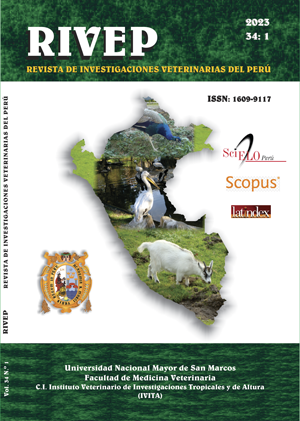Perceptions about the presence of pigeons in public spaces and their importance in public health in a district of Lima, Peru
DOI:
https://doi.org/10.15381/rivep.v34i1.23120Keywords:
pigeon, Columba livia, public health, zoonosisAbstract
The aim of this study was to describe the population’s perception about the presence of pigeons in public spaces and its implication in public health. An instrument containing the following variables was developed and validated by experts: demographic information, perception of factors related to the presence of pigeons, the problems they can cause, their importance as a reservoir of zoonoses, population control measures, human practices in relation to pigeons, and collateral problems of public interest. In total, 402 valid surveys were collected. Among them, 89.6% of participants recognized that pigeons transmit diseases, 78.9% heard of psittacosis, 78.1% of cryptococcosis, 72.4% of histoplasmosis, 71.9% of salmonellosis and 63.2% of colibacillosis. More than 80% recognized that pigeons produce environmental contamination by droppings, are hosts to external parasites, their population increases due to having access to food and water, and this must be controlled. The 76.6% of people prefer municipal sanctions as a control method, while 70.9% were unaware of the existence of the Municipal Ordinance that regulates the control of pigeons in the district and less than 20% perceived that the animal welfare of pigeons was affected. The study may be useful to assess the need to update, modify and incorporate actions to control pigeon populations in the Lince district, Lima, Peru.
Downloads
Downloads
Published
Issue
Section
License
Copyright (c) 2023 María del Carmen Arteaga, Iván Asmat, Daphe León, Néstor Falcón

This work is licensed under a Creative Commons Attribution 4.0 International License.
AUTHORS RETAIN THEIR RIGHTS:
a. Authors retain their trade mark rights and patent, and also on any process or procedure described in the article.
b. Authors retain their right to share, copy, distribute, perform and publicly communicate their article (eg, to place their article in an institutional repository or publish it in a book), with an acknowledgment of its initial publication in the Revista de Investigaciones Veterinarias del Perú (RIVEP).
c. Authors retain theirs right to make a subsequent publication of their work, to use the article or any part thereof (eg a compilation of his papers, lecture notes, thesis, or a book), always indicating the source of publication (the originator of the work, journal, volume, number and date).



